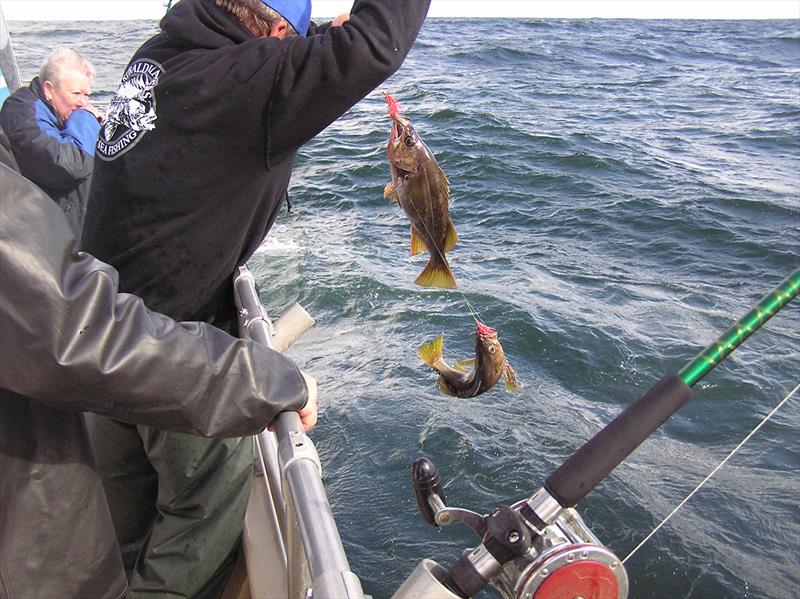
New recreational rockfish fishery off Oregon
by NOAA Fisheries 7 Apr 2018 12:18 UTC

Yellowtail rockfish on line © John Holloway / Recreational Fishing Alliance
Oregon fishermen have more opportunities to catch rockfish, or groundfish, following NOAA Fisheries’ approval of a new ocean fishery that uses selective gear to target plentiful species off Oregon while avoiding overfished species.
NOAA Fisheries this week announced a final rule authorizing a new Oregon recreational fishery for groundfish, such as yellowtail and widow rockfish, at midwater depths greater than 40 fathoms. Recreational fishing for rockfish off Oregon generates more than $14 million for the state’s economy annually and has been the largest recreational ocean fishery in the state in recent years. The new fishery is expected to add to these economic benefits.
“People have been waiting a long time for this, so it’s a great opportunity to expand opportunities while still protecting those fish that need it,” said John Holloway of the Recreational Fishing Alliance in Oregon and chair of the Groundfish Advisory Subpanel at the Pacific Fishery Management Council (PFMC). The PFMC endorsed the new fishery, which will begin in April.
Since 2004, recreational fishermen pursuing rockfish in Oregon had been limited to shallow depths during peak summer months to avoid impacts on overfished deeper water species such as yelloweye rockfish. That left some coastal communities with no recreational fishing for groundfish, a mainstay of the coastal economy.
The new fishery, which operates around offshore reefs at midwater depths, will also help disperse fishing pressure from nearshore reefs and reducing the likelihood that nearshore fishing will hit its limits and close early, as it did last year. It will also give charter boats an alternative to salmon fishing in years of low salmon abundance.
Holloway helped suggest the new recreational fishery some 10 years ago, drawing on a commercial fishing method using a “long leader,” a type of hook and line gear, which suspends hooks and lures at least 30 feet off the sea floor. That avoids sensitive groundfish species such as yelloweye rockfish that dwell on the bottom and are still recovering from overfishing in the 1990s.
Recreational fishermen tested the long-leader method under an Exempted Fishing Permit (EFP) supported by the PFMC and authorized by NOAA Fisheries that gave them special permission to fish in Rockfish Conservation Areas usually closed to fishing. They found that long-leader gear catches plentiful species that live higher in the water column, while almost entirely avoiding overfished species, such as yelloweye, that are managed under rebuilding plans to increase their population.
“The fishing community helped demonstrate to us that long leaders caught the fish they wanted to catch, and now the fishing community is benefiting,” said Gretchen Hanshew, Branch Chief for Groundfish and Coastal Pelagic Species in NOAA Fisheries’ West Coast Region. “It took some time, but fishing communities and the economy should all benefit.”
The Oregon Department of Fish and Wildlife (ODFW) provided onboard observers to support the EFP fishing, as well as assistance in developing an environmental assessment and drafting new regulations allowing the fishery.
A state report on the experimental fishing aboard charter boats from Newport and Depoe Bay concluded that the long-leader gear has “much lower bycatch rates for yelloweye and canary rockfish in comparison to current West Coast recreational fishing practices.” NOAA Fisheries helped fund the test fishing.
The numbers back up the findings. During test fishing over a three-year period fishermen caught hundreds of rockfish weighting 5.4 metric tons but only two yelloweye, Holloway said.
“We were fishing in the middle of the area and hardly catching any yelloweye,” he said. He praised the collaboration between fishermen and managers to test and apply an innovative fishing method that benefits both fishing and the environment. “It’s a simple approach that works for everyone.”
More information on midwater groundfish fishing from the Oregon Department of Fish and Wildlife.
More information on Rockfish Conservation Areas on the West Coast.